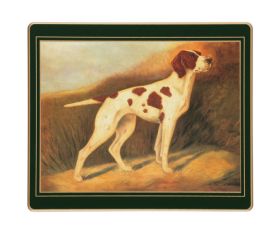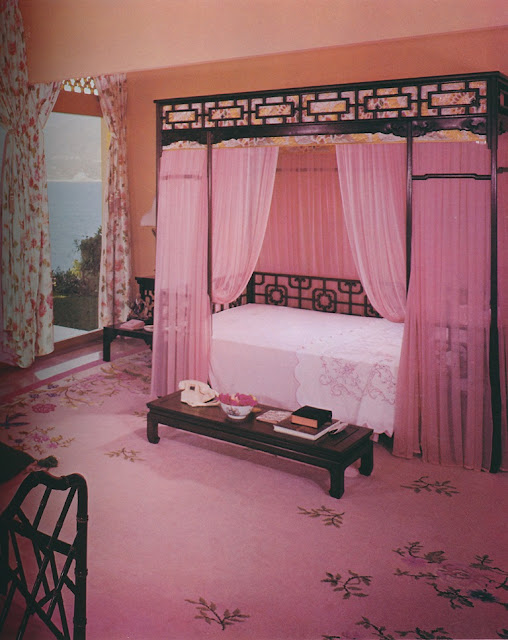A while back, a reader requested that I feature the work of French designer François Catroux. Catroux, of course, is a "big name" designer, but photos of his work are not always easy to find. While looking through the August 1984 issue of House & Garden over the weekend, I stumbled upon an article about his Paris apartment, located in the Left Bank's quartier de l'Odéon. It's so interesting to see photos of his home close to thirty years after it was published because so much of the interiors look stylish still today.
According to the article, Catroux had coveted this apartment for some time. The quartier de l'Odéon is filled with residences that cannot be altered because of their historical heritage, but this particular ground-floor apartment did not come with such restrictions. With a free hand to renovate and decorate the home, Catroux decided to devote his home to what the article referred to as an "abstract" form of classicism. As Catroux said, "After all, what is classicism but that which remains forever modern?" As such, Catroux used a building material known as staff, a combination of mixed plaster and fiber, to create cornices, Doric columns, and rusticated wall finishes that, although essentially pastiche, give the home a classical flavor.
Neutral colors pervade the home with the exception of the red bed covering, while serious antiques like Louis XVI chairs are hidden beneath canvas slipcovers. And in an effort to keep the rooms from looking overdecorated, Catroux chose to leave the canvas that is hung portière-style between the home's dining room and petit salon unhemmed, saying, "I'm never happy when an apartment is too finished." But of all the chic furnishings in the home, my favorite is the trompe l'oeil carpet that is installed throughout the apartment. Designed by Catroux himself, the carpet mimics a marbled floor, something that brings to mind that fabulous trompe l'oeil "marble tile" rug in the bedroom of Lady Sackville at her Brighton House. (Sackville's bedroom was decorated with the help of her friend, architect Sir Edwin Lutyens.)
A recent WSJ article showed photos of the Catroux Paris apartment that look quite different from what you see here. Whether they live in the same apartment as seen here or not, I do not know. Regardless, I think these photos prove that classic design and, yes, classicism, remain timeless. And to the reader who requested this Catroux post, I hope that you haven't yet seen these photos before!
Image at top: An Indonesian throne and bull funerary sculpture greeted visitors in the apartment's entrance hall.
The petit salon with Doric columns made of staff and architectural plans hung on the wall.
A Sèvres vase stands on top of a Directoire table supported by Sèvres biscuit lion and paw legs.
The sitting room. Here, a statue of Atlas and 19th c. English architectural orders mingle with Art Deco sculpture.
The luxurious dining room is kept from looking too rich thanks to canvas slipcovers and curtains.
The master bedroom. To the right you'll notice a concrete support for the spiral staircase, a design borrowed from those used in parking lots.
The bathroom with faux-marbre moldings and embossed walls.
Every room of the home looks out onto the tranquil garden.
All photos and quotations from House & Garden, August 1984; article author Christina de Liagre and photographer Michael Boys.
















 by Francoise Mohrt; photos #2-6 from House & Garden, 1985 and 1992. #7-8 from
by Francoise Mohrt; photos #2-6 from House & Garden, 1985 and 1992. #7-8 from  .
.

















 by Felicity Wigan; Eastnor Castle photo from
by Felicity Wigan; Eastnor Castle photo from  by John Martin Robinson; Birr Castle photo from
by John Martin Robinson; Birr Castle photo from  by Sybil Connolly.
by Sybil Connolly.








 ; #2-#5 from
; #2-#5 from  ; #7 and #8 from
; #7 and #8 from  .
.















 by Mary-Sargent Ladd. During my initial flipping through, I saw a photo of Jacqueline de Ribes, a woman whose style I greatly admire. Just look at her, above, wearing that fabulous silk caftan not to mention her perfectly made-up face and coiffed hair. And yet, when I turned the page to see photos of her bedroom, I was a little surprised. Not that there is anything wrong with her bedroom (see above), but it just wasn't what I was expecting. I suppose that I assumed her bedroom would be brighter and layered with matching fabrics. But it wasn't. Well, as they say, you should never assume anything.
by Mary-Sargent Ladd. During my initial flipping through, I saw a photo of Jacqueline de Ribes, a woman whose style I greatly admire. Just look at her, above, wearing that fabulous silk caftan not to mention her perfectly made-up face and coiffed hair. And yet, when I turned the page to see photos of her bedroom, I was a little surprised. Not that there is anything wrong with her bedroom (see above), but it just wasn't what I was expecting. I suppose that I assumed her bedroom would be brighter and layered with matching fabrics. But it wasn't. Well, as they say, you should never assume anything.
























 . As most of you are probably aware, the book profiles the Hunting Lodge, Nicky's enchanting country house that once belonged to John Fowler. Perhaps it was the allure of these two designers that had me eagerly anticipating the release of this book. Whatever the reason, the book turned out to be exactly as I had hoped: interesting, inspirational, and hands down a fun read.
. As most of you are probably aware, the book profiles the Hunting Lodge, Nicky's enchanting country house that once belonged to John Fowler. Perhaps it was the allure of these two designers that had me eagerly anticipating the release of this book. Whatever the reason, the book turned out to be exactly as I had hoped: interesting, inspirational, and hands down a fun read.




 by Nan Kempner and Alex Hitz's
by Nan Kempner and Alex Hitz's  , if you have them- and you'll find mentions of that famous Southern belle, Marguerite Littman. Born in Monroe, Louisiana but a resident of London for decades, Littman has charmed legions of people and amassed numerous interesting friends throughout her life. Well-known for both teaching Elizabeth Taylor how to "speak Southern" for her role in Cat on a Hot Tin Roof and supposedly being the inspiration for Truman Capote's Holly Golightly, Littman is also a noted hostess, often gathering her guests in the dining room of her Chester Square townhouse.
, if you have them- and you'll find mentions of that famous Southern belle, Marguerite Littman. Born in Monroe, Louisiana but a resident of London for decades, Littman has charmed legions of people and amassed numerous interesting friends throughout her life. Well-known for both teaching Elizabeth Taylor how to "speak Southern" for her role in Cat on a Hot Tin Roof and supposedly being the inspiration for Truman Capote's Holly Golightly, Littman is also a noted hostess, often gathering her guests in the dining room of her Chester Square townhouse. , David Hicks decorated the home that Marguerite shares with her barrister husband, Mark, sometime in the 1960s. Hicks's work included covering the dining room's walls, windows, and table in a red floral print cotton. Hanging above the round dining table was an antler chandelier that evidently had an eyeball spotlight placed above it. What the book doesn't mention is whether the chandelier was Hicks's choice or that of the Littmans.
, David Hicks decorated the home that Marguerite shares with her barrister husband, Mark, sometime in the 1960s. Hicks's work included covering the dining room's walls, windows, and table in a red floral print cotton. Hanging above the round dining table was an antler chandelier that evidently had an eyeball spotlight placed above it. What the book doesn't mention is whether the chandelier was Hicks's choice or that of the Littmans. , was published. In the book, a photo of the Littmans' dining room appears, still wearing the same vibrant floral fabric. But, by 2000 when Nan Kempner's book was released, the dining room had undergone a big change. Gone was the crimson fabric, with stripes now taking the place of flowers on the room's walls. The antler chandelier did, however, remain a prominent feature in the room. I do wonder how the room looks today.
, was published. In the book, a photo of the Littmans' dining room appears, still wearing the same vibrant floral fabric. But, by 2000 when Nan Kempner's book was released, the dining room had undergone a big change. Gone was the crimson fabric, with stripes now taking the place of flowers on the room's walls. The antler chandelier did, however, remain a prominent feature in the room. I do wonder how the room looks today.




 , which features quite a few photos of Lady Baillie's Nassau home.
, which features quite a few photos of Lady Baillie's Nassau home.












 . (If you like the first episode, beware of binging on the rest of them as I have.) The show is stylish, fun, a little lighthearted, and well-written. I have two remaining episodes to watch, and I'm not sure what I'm going to do once I finish them. The second season is currently being filmed in Australia as I write this, so I'm sure that means American viewers will have to wait until next Spring to catch new episodes.
. (If you like the first episode, beware of binging on the rest of them as I have.) The show is stylish, fun, a little lighthearted, and well-written. I have two remaining episodes to watch, and I'm not sure what I'm going to do once I finish them. The second season is currently being filmed in Australia as I write this, so I'm sure that means American viewers will have to wait until next Spring to catch new episodes. 















 , the photographer wrote that Oberon's Acapulco house, La Consentida, was considered to be the most beautiful vacation home in the world. And yet, when I did some sleuthing around the internet, it seems that around this same time, Oberon and her Italian industrialist husband, Bruno Pagliai, also resided in an Acapulco estate called El Ghalal. So, what's the deal?
, the photographer wrote that Oberon's Acapulco house, La Consentida, was considered to be the most beautiful vacation home in the world. And yet, when I did some sleuthing around the internet, it seems that around this same time, Oberon and her Italian industrialist husband, Bruno Pagliai, also resided in an Acapulco estate called El Ghalal. So, what's the deal? , which devotes a chapter to Oberon and Pagliai's home, this time referred to simply as Ghalál. The book refers to the home mostly in the past tense, noting that Oberon once shared the home with her former husband. So, I am assuming that when AD first ran photos of the home, the Oberon-Pagliai marriage was intact, but by the time the compilation book was published, the marriage was no more.
, which devotes a chapter to Oberon and Pagliai's home, this time referred to simply as Ghalál. The book refers to the home mostly in the past tense, noting that Oberon once shared the home with her former husband. So, I am assuming that when AD first ran photos of the home, the Oberon-Pagliai marriage was intact, but by the time the compilation book was published, the marriage was no more. , which in turn inspired the mini-series of the same name. (A mini-series, I might add, that is actually pretty good. And Korda, just in case you don't know, is Oberon's nephew.)
, which in turn inspired the mini-series of the same name. (A mini-series, I might add, that is actually pretty good. And Korda, just in case you don't know, is Oberon's nephew.) 










 , because it featured Stefanidis' small library.
, because it featured Stefanidis' small library.







